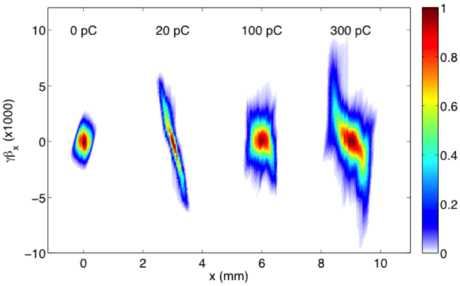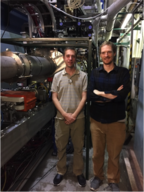CLASSE NEWS | 2 Dec 2014

Cornell injector is first to meet specs for new X-ray source
The Cornell electron source is the world's brightest, and recently it showed that it is capable of meeting the demands of LCLS-II, a future powerful X-ray source that is to be built at SLAC National Accelerator Lab. So far, it is the only source to have succeeded, though an injector at Lawrence Berkeley National Lab hopes to do so soon. The Department of Energy is building a new hard x-ray source using a free electron laser (FEL) at SLAC in Stanford, California, called LCLS2 (linac coherent light source 2). The accelerator group at CLASSE is a big part the initial design efforts for this new source of high-intensity, ultrafast x-ray pulses. Scientists at CLASSE are collaborating with several national labs to develop the technology required to make this machine a success, including work on superconducting RF cavities and bright electron beams. Researchers Adam Bartnik and Colwyn Gulliford have led the efforts to demonstrate that the Cornell high-brightness injector (originally developed for future light sources using energy recovery linac technology) can produce an electron beam 'bright' enough to efficiently drive the FEL x-ray production process. A 'bright' electron beam means packing as many electrons as possible into a small volume without ruining the nearly laser-like properties of the electron beam. The brighter the electron source is the better quality of x-rays that are produced at the end of the accelerator. Making the injector work requires figuring out how to set dozens of parameters for magnets, accelerating cavities, lasers and high voltage. Sophisticated electron beam simulation programs are used, in conjunction with genetic algorithm optimization tools, to find the best solution to meet the requirements of the FEL. Demonstrating that these simulations are accurate and match the measurements made on the real injector is an important goal for this project. The experimental results are shown in the figure 2 below. We measure the beam 'phase space', which is found by plotting the position versus angular spread of the electrons in the beam. Smaller 'phase space' corresponds to a brighter beam. The beam properties were measured for different amounts of charge per bunch of electrons, according to the needs of the FEL. The measurements show that the Cornell injector meets all of the requirements for the new LCLS2 x-ray source at Stanford. Also, the measurements closely match the detailed computer simulations, giving us confidence for how we design future electron sources.
This plot shows the experimental measurement results of the 'phase space' of the electron beam. The x-axis shows the position of the electrons in each bunch, and the y-axis shows the angular spread of the electrons. The FEL can operate at different bunch charges, shown as 20, 100, and 300 picoCoulombs (pC).

